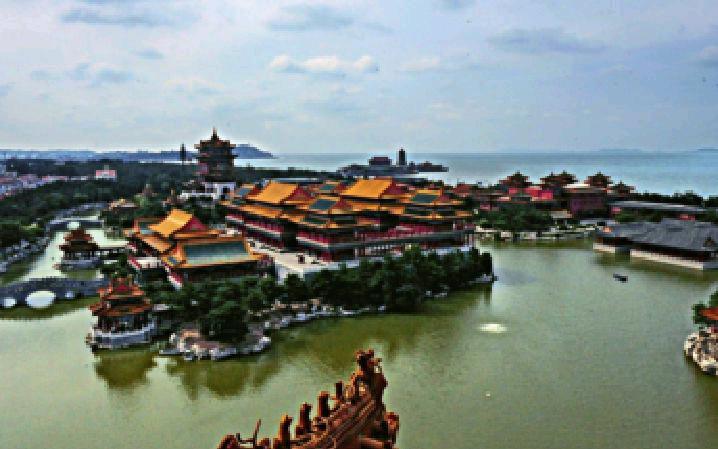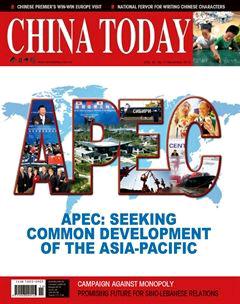Shandong’s Legacy
By+XU+HAO
MANY Chinese cities have stamped their names on the pages of the nations long history by virtue of their rich culture and historic events. In February 1982, in order to protect Chinese cities where important political, cultural and economic events had played out, the Chinese government officially proposed the designation of “historical and cultural cities.”
Those historical and cultural cities, on the one hand, open a window for people to view Chinese history; on the other, they build a brand effect for the cities themselves. How best to preserve those historical and cultural cities and produce optimum results from their brand effect is a subject that demands deep research.
From September 15 to 19, I joined a research group on a trip to Shandong Province, birthplace of Confucius, to visit the many historical and cultural cities there.
Competitive Edge
“History and culture are the soul of a city, as well as the core of a citys soft power and potential competitiveness. They are the source of a citys deep value. Abundant historical and cultural resources give a city its distinctive charm and quality, and only with these intact can it be attractive and influential in the long run,” said Li Jianjun, vice director of the publicity department of the CPCs Shandong Provincial Committee.
According to Wang Shinong, director of the press office of the provincial government, Qufu was included among the first batch of national historical and cultural cities in 1982. Thereafter, Jinan, Qingdao, Liaocheng, Linzi, Zoucheng, Taian, and Penglai successively won this epithet. Last year, Yantai and Qingzhou were included, bringing the total number of such cities in Shandong to 10.
“The honor is not only an affirmation of the scientific development of those 10 cities, but also high-level recognition of their cultural consciousness, confidence and self-improvement in urban management. Practices of these cities testify that the protection of historical and cultural heritage will not adversely affect the eco-nomic development or social advances of a city, or peoples livelihood, but on the contrary, the distinctive historical and cultural resources will provide strong and sustained impetus to the citys development,” explained Li.
“Strengthening scientific preservation and rational utilization of historical and cultural sites has a powerful impact on such aspects as transforming regional development models, promoting harmonious development of local societies and economies and comprehensively enhancing the quality of urbanization,”said You Shaoping, deputy director of the Shandong Provincial Bureau of Cultural Heritage. Mr. You also pointed out that cultural heritage resources, as an indispensable pillar for developing the local economy and tertiary industry, play a key role in improving the form of economic operation and boosting socioeconomic development.
Revitalize Ancient Culture
Linzi was the capital of the ancient State of Qi (around 1046 – 221 BC) and the birthplace of Qi culture. It served as the capital for over 800 years, from the period when military strategist Jiang Ziya established the State of Qi until it was conquered by the State of Qin, the first centralized empire of China. When I visited Linzi, I saw that most of the citys ancient architecture was lost; what remains today are just place names. But the local government is taking great steps to fix this problem.
The renowned ancient Chinese historical work Zhan Guo Ce (Strategies of the Warring States) records that the State of Qi extended some 1,000 kilometers. Linzi was a rich city and its residents enjoyed many entertainment activities, such as playing a variety of musical instruments, cock fighting, and Cuju, an archetype of modern football.
Since the 1970s, experts in international sports history have repeatedly pointed out that Cuju, which first appeared over 2,300 years ago in ancient China and was a popular sport in Linzi, is the origin of modern football. On July 15, 2004 at the opening ceremony of the Third International Football Expo in Beijing, FIFA president Sepp Blatter formally announced the origin of soccer– Linzi, Shandong Province.
In 2006, Cuju was included on the first list of Chinas national intangible cultural heritage. In order to better pass on the cultural legacy, Linzi launched Cuju classes in all its middle and elementary schools to revive the ancient sport. Moreover, Linzi has taken advantage of its status as the birthplace of “The Beautiful Game” in its city planning and construction by building relevant sculptures and symbolic constructions around the city, trying to elevate the citys image among local people and tourists.
During the 10th China (Linzi) Qi Culture Festival this year, the organizers invested much time and effort in promoting Cuju, digging deep to get to the essence of Qi culture. “Efforts should be made to expand the Qi culture industrial chain and give full play to the cultural influence of Cuju to build the Qi culture brand and to introduce Linzi to the world,” said Ma Guoqing, an expert in Qi culture and curator of Shandong Linzi Qi Culture Museum.
The Myth Becomes Reality
According to Shiji (Records of the Historian), there were once three mysterious mountain islands, Penglai, Fangzhang, and Yingzhou, where immortals lived. On September 17, I experienced the real wonderland of the Sanxian Mountains (three mysterious mountains) Scenic Area in Penglai.
Based on the myth of these immortals, the scenic area was launched in 2004 by Penglai Baxianguohai Tourism Co., Ltd. and took three years to build. It brings it to life, transforming the wonderland of peoples fancy into reality.
The sites in the area are fashioned after famous Chinese images: the painting The Penglai Isle of the Immortals by Chinese landscape painters Yuan Jiang and Yuan Yao of the Qing Dynasty (1644-1911), the painting Eighteen Scholars Ascend Yingzhou by Zhao Mengfu, a Chinese painter and calligrapher during the Yuan Dynasty (1271-1368), and a grand building in the Yuanmingyuan(the Old Summer Palace) in Beijing, the Qing imperial park looted and torched by foreign invaders.
Wang Changwei, vice director of the management committee of the Penglai City tourist resort, spoke of how Penglai has actively promoted characteristic culture tourism and extended its industrial chain, prompting the local tourist industry to realize a mixed model of development. By 2013, there had been 6.02 million tourist visits to Penglai, bringing in an overall revenue of RMB 6.1 billion, 33.9 percent of the tertiary industrys added value.
“So far, the layout of the old city area of Penglai has been well-preserved. During its renovation and construction we paid great attention to preserving tradition and the original culture without large-scale demolition or reconstruction; the old architectural relics have been well protected and enriched with optimized greening projects and scenic spots. Protection of the old and development of the new are well balanced,” said Hou Xinghua, vice director of the planning department at the Penglai municipal bureau of housing, planning and construction.
Faithful to the Past
On September 18, I visited the area around Chaoyang Street in Yantai City, where I saw many old constructions with distinctive characteristics skirting the mountains and sea. The area used to house the consulates of 17 countries. Nowadays, it is the cradle of Yantais modern manufacturing industry, witnessing over 150 years of history since the city opened as a commercial port. According to Xu Mingjiang, vice director of the archeology department of Yantai Museum, Chaoyang Street was first constructed in 1872 and is a typical example of Yantai port culture. “This was a busy commercial street, full of stores, foreign firms and post offices in constructions with both Chinese and foreign characteristics,” said Xu.
Zhang Weigong, director of the rural planning department of Yantai Planning Bureau, emphasized that the preservation of historical and cultural cities doesnt only refer to the protection of ancient architecture and cultural relics. Many elements constitute the historical and cultural environment of Yantai, such as traditional residential houses, modern constructions, view corridors and ancient and rare trees. “Therefore, the newly built residential constructions in the historical and cultural preservation area should be coordinated with the existing ancient constructions in terms of height, color and signage,” Zhang said.
Qingdao, which is famous for the image of red-tile roofs, green trees, blue sea and an azure sky, was designated a national historical and cultural city by the State Council in January 1994. With just over 100 years of history, Qingdao is young. However, due to its special historical background, its old urban area consists of many European-style constructions.
Moreover, the beautiful natural environment – the combination of sea and mountain views and the imposing style of its urban planning – gives Qingdao its distinctive architectural culture.
The Ba Da Guan (literally, the eight great passes) district in Qingdao, featuring clusters of historical mansions, is a typical example of the construction culture of Qingdao. The area has 320-odd old houses and was designated a major historical and cultural site affording national protection by the State Council in June 2001. In 1897 after Germany occupied Jiaozhou Bay, houses in the style of 20-odd countries, such as Russia, Britain, France, Germany, America, Japan, Denmark, Greece and Spain, were built in Ba Da Guan, earning it the reputation as the “Architectural Expo of All Nations.”
Let the People Benefit
Qingzhou is named after one of the nine provinces that were recorded in the Yu Gong geography chapter of the classic Book of Documents. On November 18, 2013, Qingzhou was designated a famous historical and cultural city by the State Council. On September 16, I visited Beimenli Ancient Street, full of old alleys and ancestral halls. Days gone by are vividly reproduced along the street: Senior residents play chess under trees; an old man in a red gown performs Shandong Kuaishu, a form of story-telling; various folk performances play out; folk handicrafts are on display.
Beimenli Ancient Street has witnessed the rise and fall of Qingzhou. According to Li Jiangtao, vice president of Qingzhou Cultural Industry Association, the preservation and renovation of the street is part of the larger preservation project of the old city area, which was launched in 2012.
The Qingzhou municipal government is proactive in protecting the citys intangible cultural heritage. According to Ma Aijuan, director of operations at the Qingzhou Intangible Cultural Heritage Preservation Center, the municipal department of finance allocates RMB 1.5 million every year for the salary of performers, applying the principle of “the government buys the service to let the people enjoy the service” to preserve and revitalize these intangible cultural heritage programs.

